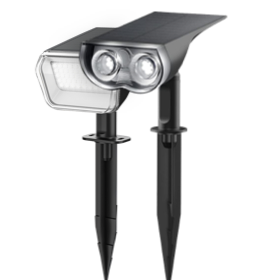How to Fix Solar Lights: A Step-by-Step Troubleshooting Guide
- “How to Fix Solar Lights?”
- Most solar light failures are caused by dirty panels, dead batteries, or water damage. Clean panels with a mild solution, replace rechargeable batteries every 2–3 years, and reseal cracked housings with silicone. For persistent issues, reset sensors or check wiring connections.
Solar lights offer eco-friendly illumination---until issues like dimming, flickering, or solar lights not working strike. This guide simplifies troubleshooting and repair, covering root causes from battery degradation to environmental wear. Follow these steps to restore performance and extend your lights’ lifespan.
In This Article:
- Why Solar Lights Fail: Top 5 Causes
- Essential Tools for Solar Light Repairs
- Step-by-Step Troubleshooting Guide
- Solar Light Not Working Even with New Battery?
- Preventing Future Failures
- FAQ
We’ll cover everything from dirty panels to faulty sensors, empowering you to revive your solar lights and avoid costly replacements. Let’s get your outdoor space glowing again!

Why Solar Lights Fail: Top 5 Causes
Solar lights are designed for simplicity, but their reliance on environmental energy and delicate components makes them prone to specific failures. Understanding these vulnerabilities—from sun-starved panels to aging batteries—helps you diagnose issues faster and implement lasting fixes. Below, we dissect the five most common culprits, pairing technical insights with actionable solutions to restore your lights’ glow.
Dirty or Shaded Solar Panels
Impact: Dust, pollen, or partial shade can slash charging efficiency by 50–70%, forcing panels to work twice as long for the same energy output.
Science: Panels rely on unobstructed photons to trigger the photovoltaic effect. Even light debris (e.g., bird droppings) blocks critical wavelengths.
Fix:
- Clean panels weekly with a 1:1 vinegar-water solutionto dissolve grime.
- Trim foliage to ensure 6+ hours of daily sunlight exposure.
- Avoid placing lights under trees or eaves where shadows linger.
Recommend Linkind Outdoor Solar Spotlights
Upgrade to Bright Solar Landscape Lights like the Linkind Adjustable Solar Spotlights. Their dual-pivot design lets you angle both the panel and light head independently, maximizing sun exposure even in tricky spots. Whether it’s a shaded garden corner or a partially covered patio, these lights adapt effortlessly. With 350 lumens of brilliance and 10 ultra-bright LEDs, they cut through darkness while their IP67-rated ABS housing laughs off rain, snow, and dust. Bonus? The color-changing modes add a dash of magic to your evenings.
Key Selling Points:
- 360° Flexibility: Tweak panels and lights to chase the sun, boosting energy harvest.
- Vivid & Versatile: Choose from 6 fixed colors or let the auto-mode paint your yard in dynamic hues.
- No-Wiring Wonder: Install anywhere—no digging, no cables, just pure solar freedom.

- Adjustable Solar Panel: Both the solar panel and light head are independently adjustable, improving solar conversion efficiency and providing flexible lighting angles.
- Super Brightness: Despite their small size, each spotlight delivers 350lm brightness with 10 high-brightness LED beads, ensuring a bright and safe outdoor environment.
- Color Options: The spotlights offer multiple color-changing options, including 6 fixed colors and 1 auto-changing mode, creating a magical atmosphere.
- High Durability: Made from high-quality ABS material, these IP67 waterproof lights withstand extreme weather conditions, ensuring long-lasting performance.
- Eco-friendly Installation: Easy to install without digging or cables, these solar-powered spotlights use advanced technology for cost-effective and eco-friendly outdoor lighting.
Dead or Corroded Batteries
Lifespan: Rechargeable batteries (NiMH or lithium-ion) degrade after 2–3 years, losing capacity due to charge cycles and temperature extremes.
Symptoms: Shortened runtime, flickering LEDs, or failure to charge fully.
Fix:
- Replace NiMH batteries every 2 years; lithium-ion every 3–4 years.
- Scrub corroded terminals with a pencil eraser and apply dielectric grease.
- Store lights indoors during extreme cold to preserve battery health.
Water Damage
Risk: Cracked seals or poor drainage let moisture corrode circuitry, causing erratic behavior or total failure.
Data: Non-weatherproof models fail 3x faster in rainy or humid climates.
Fix:
- Reseal housings with silicone geland drill 1/8-inch drainage holes at the base.
- Dry waterlogged components with a hairdryer on low heat.
- Prioritize lights with IP65+ ratingsfor outdoor durability.
Faulty Light Sensors
Failure Modes: Dirty or misaligned sensors keep lights on during the day or off at night.
Test: Cover the sensor with opaque tape—if the light activates, the sensor is faulty.
Fix:
- Clean sensors monthly with a microfiber cloth and isopropyl alcohol.
- Reset the system by removing batteries for 30 secondsto clear sensor errors.
- Ensure sensors face away from artificial light sources (e.g., porch bulbs).
Burnt-Out LEDs
Lifespan: LEDs typically last 50,000+ hours but fail early due to voltage spikes or moisture.
Diagnosis: Use a multimeter’s continuity mode—no signal indicates a dead LED.
Fix:
- Replace burnt LEDs with 5–3V compatible models(solder required).
- Install a surge protector to stabilize voltage from fluctuating panels.
- Avoid submerging lights or exposing LEDs to direct rain.
Pro Tip: Prevent 80% of failures with monthly panel cleaning, annual battery checks, and weatherproofing upgrades. A little proactive care ensures your solar lights shine bright, season after season.
Essential Tools for Solar Light Repairs
Repairing solar lights requires precision and the right tools to tackle everything from corroded batteries to faulty sensors. Whether you’re troubleshooting flickering LEDs or resealing water-damaged housings, having these tools on hand ensures efficient diagnostics and lasting fixes. Below, we break down the must-have toolkit for solar light repairs, explaining how each item contributes to restoring your outdoor glow.
Multimeter (15–15–30): Measures battery voltage (e.g., 1.2V NiMH or 3.2V LiFePO4) and tests LED continuity to pinpoint failures.
Soft Cloth & Isopropyl Alcohol: Removes dirt, pollen, and oxidation from solar panels and battery terminals without scratching surfaces.
Screwdriver Set: Opens light housings to access batteries, sensors, and wiring. Phillips and flathead types cover most models.
Silicone Sealant: Reseals cracked housings and gaskets to block moisture. Opt for clear, UV-resistant formulas.
Replacement Batteries: Swaps degraded batteries to restore runtime. NiMH suits budget fixes; LiFePO4 offers longer lifespan and cold resistance.

Pro Toolkit Checklist:
- Keep a small containerfor screws and components during disassembly.
- Label batteries with installation dates to track replacement cycles.
- Store tools in a dry, organized case to prevent rust or loss.
Final Note: With these tools, you’re equipped to tackle 90% of solar light issues. Regular maintenance and prompt repairs ensure your fixtures shine bright, season after season.
Recommend Linkind StarRayS Outdoor Solar Spotlights
Skip the repair hassle with Linkind StarRayS Spotlights—a compact powerhouse designed for zero maintenance. Their 350-lumen output illuminates trees, pathways, and decor with crisp precision, while the dual lighting modes (12 hours on low, 6 hours on high) balance efficiency and visibility. The 180° adjustable head ensures optimal solar panel positioning, and the IP67-rated shell withstands monsoons and blizzards alike. Perfect for Halloween displays or year-round ambiance, these lights blend durability with plug-and-play simplicity.
Key Selling Points:
- Set It & Forget It:Auto on/off and long-lasting lithium battery eliminate daily checks.
- Tough & Tiny:Smaller than your phone but tough enough for extreme climates.
- Multi-Scene Master:Ground-stake or wall-mount options adapt to any space.

-
Compact Brightness: This 350 lumen Halloween solar spotlight is space-efficient and illuminates trees, walls, and decorations effectively.
-
Dual Modes: With a large lithium battery, it offers 12 hours on low and 6 hours on high, automatically turning on at night.
-
Adjustable Angle: The head tilts 180° horizontally and 90° vertically for optimal solar exposure and focused lighting on decorations.
-
Flexible Installation: Mount it on walls or use the ground stake, ideal for patios, pools, gardens, and more.
-
Weatherproof Design: IP67 rated for all weather conditions, made from durable ABS, and FCC/CE certified for reliability.
Step-by-Step Troubleshooting Guide
Solar light issues often stem from interconnected problems—dead batteries, dirty panels, or faulty wiring. A systematic approach ensures you pinpoint the root cause efficiently, avoiding guesswork and wasted effort. Follow this guide to diagnose and resolve issues methodically, whether you’re dealing with dim lights, erratic sensors, or total failure.
Check the Power Source
If your solar light isn’t charging, ask: Do Solar Lights Need Direct Sunlight? While they can work in indirect light, performance drops significantly. Clean panels and reposition lights to a sunnier spot. For Modern Solar Lights with MPPT technology, even cloudy days yield better energy conversion.
Inspect Wiring & Connections
Examine the internal wiring and terminals for damage. Look for frayed wires, cracked insulation, or corroded contacts (green/white buildup). Re-solder loose connections using a 30W soldering iron, replace damaged wires with heat-shrink tubing, and scrub corroded terminals with a pencil eraser. Apply dielectric grease to terminals after cleaning to prevent future corrosion.
Test the Light Sensor
Cover the light sensor with opaque tape during daylight hours. If the light turns on, the sensor is faulty—clean it with isopropyl alcohol to remove dirt or residue. If the issue persists, relocate the light away from artificial light sources (e.g., porch bulbs) that may interfere with its dusk-to-dawn function.
Diagnose LEDs
Use a multimeter in continuity mode to test LEDs. Touch the probes to the LED terminals; if there’s no beep, the LED is burnt out. Desolder the faulty LED and replace it with a 2.5V–3V compatible model, ensuring correct polarity. For added protection, install a 100–200Ω resistor in series with new LEDs to prevent voltage spikes.
Solar Light Not Working Even with New Battery?
Even after replacing batteries, solar lights can remain unresponsive due to overlooked technical quirks or compatibility issues. This section explores why new batteries don’t always guarantee a fix—and how to resolve these hidden hurdles.
Why It Happens
A fresh battery doesn’t always mean restored functionality. Common oversights or component failures can sabotage your repair efforts:
Reversed Polarity: Inserting batteries backward disrupts the circuit, blocking energy flow.
Defective Charge Controller: A malfunctioning controller fails to regulate power between the panel and battery.
Voltage Mismatch: Using non-rechargeable alkaline batteries (1.5V) instead of rechargeable NiMH (1.2V) or LiFePO4 (3.2V) strains the system.
The Fix
Addressing these issues requires precision and adherence to manufacturer specs:
Verify Battery Orientation: Ensure the +/- terminals align with the housing markings.
Reset the Light: Clear system glitches by removing batteries for 30 seconds, then reinstalling.
Match Battery Specs: Use only rechargeable batteries with voltage and chemistry specified in the manual (e.g., 1.2V NiMH).
How to Reset Solar Lights
Resetting reboots the light’s internal system, erasing errors caused by voltage spikes or moisture:
- Turn Off the Light: Switch to the "Off" position if available.
- Remove Batteries: Disconnect power for 30 secondsto drain residual charge.
- Reinsert Batteries: Ensure correct orientation.
- Cover the Panel: Block sunlight for 5 secondsto trigger a sensor reset.
- Uncover to Reactivate: The light should now follow its normal dusk-to-dawn cycle.
Preventing Future Failures
Proactive maintenance is the key to maximizing solar light lifespan and minimizing unexpected breakdowns. By addressing vulnerabilities before they escalate, you ensure consistent performance through seasons and weather extremes. Below, we outline routine tasks and strategic upgrades to keep your lights shining bright.
Maintenance Schedule
A structured care routine prevents 80% of common failures. Tailor these tasks to your climate and usage patterns:
Monthly Tasks: Clean solar panels with a soft cloth to remove dust and debris, ensuring unobstructed sunlight. Tighten loose screws on housings to prevent moisture entry and structural wear.
Seasonal Tasks: In freezing climates, store lights indoors to protect batteries from cold damage. Replace NiMH batteries every 2 years (or LiFePO4 every 5–7 years) to maintain efficiency.
Repair vs. Replace: When to Upgrade
Deciding whether to fix or replace hinges on cost, damage severity, and long-term value. Use these guidelines to make informed choices:
Repair If: costs stay below 50% of a new light and core components (e.g., panels, housings) remain functional. Focus on fixes like battery swaps or resealing cracks.
Replace If: damage is severe—fried circuits, cracked housings, or advanced corrosion. Upgrade to lights with MPPT technology and IP67 waterproofing for durability and low-light performance.
Final Note: Routine care and smart upgrades turn solar lights into long-lasting, eco-friendly assets.
Recommend Linkind Smart Solar Spotlight SL5C
When it’s time to upgrade, Linkind SL5C Smart Solar Spotlights redefine reliability. Equipped with MPPT technology, they squeeze 23.5% more power from every sunbeam, ensuring your lights stay lit even on cloudy days. Control them via the AiDot app or your voice (Alexa/Google Assistant) to schedule dusk-to-dawn cycles, adjust brightness, or sync colors to music. With IP67 waterproofing and a 5C automotive-grade battery, these spotlights thrive in harsh weather, delivering up to 14 hours of runtime. Group 32 lights into 8 zones for a yard that’s both smart and stunning.
Key Selling Points:
- Brainy Brightness:App-controlled schedules and music sync turn your garden into a responsive lightscape.
- Weather Warrior:Built to endure storms, heatwaves, and sub-zero chills.
- Effortless Expansion:Create a seamless network of lights without complex wiring.

-
Enhanced Solar Efficiency: Experience 24/7 illumination with these smart solar spotlights featuring MPPT technology that improves charging by 23.5%. Premium 5C automotive-grade technology delivers up to 14 hours of continuous solar powered spotlight performance.
-
App & Voice Control: Manage your solar landscape spotlights through the AiDot app or use voice commands with Amazon Alexa and Google Home via Linkind's Bluetooth Mesh Hub for convenient control of your solar outdoor spotlight network.
-
Dynamic Color Effects:Transform your yard with color changing solar spotlights offering 16 million color options. Create stunning light shows that sync with music—perfect for enhancing your landscape with solar spotlights for yard decoration.
-
Intelligent Scheduling: Program your solar colored spotlights with smart timers including dusk-to-dawn automation and customized schedules. Set your preferred brightness levels and timing to maximize your solar landscape spotlights' effectiveness.
-
Versatile Installation: Mount these IP67 waterproof solar outdoor spotlights on walls or ground with 360° horizontal and 180° vertical adjustability. Group up to 32 lights into 8 separate zones for comprehensive yard illumination.
Recommend Linkind Smart Solar Spotlight SL5
If compatibility headaches plague your solar setup, meet the SL5 Smart Solar Spotlight. As the world’s first wirelessly group-controllable solar light, it lets you manage brightness, color temps, and schedules across multiple units via the AiDot app. Sync its 16 million colors to your favorite playlist or pick from preset scenes like "Sunset Glow" or "Midnight Sparkle." With three modes (Motion, Luminance, Continuous), it’s a security guard, ambiance creator, and party starter rolled into one. The 360° adjustable mount ensures perfect alignment, rain or shine.
Key Selling Points:
- Sync & Play:Turn your yard into a disco or a serene retreat with music-responsive lighting.
- Smart Savings:Group control cuts energy waste by illuminating only what you need.
- All-Weather Artist:Thrives in -4°F to 122°F, making seasonal transitions seamless.

-
Group Control: The world's first solar spotlight with wireless capabilities to offer smart group control functionality.
-
Multiple Convenient App Functions: Control smart spotlights with the AiDot App. Adjust color, temperature, brightness, and use group control, music sync, and energy-saving features.
-
Music Sync & Preset Scenes: Sync RGBTW smart solar lights with music by granting microphone permission. Customize effects, preset scenes, or choose from 16 million colors to enhance your outdoor ambiance.
-
Three Optional Lighting Modes: Linkind solar lights feature 3 modes: Motion for safety and efficiency, Luminance for automatic dusk-to-dawn lighting, and Continuous for constant illumination.
-
Enhanced Lighting & Easy Installation: Linkind solar spotlights are adaptable for ground or wall mounting, with 360° horizontal and 180° vertical adjustability.
Conclusion
Solar lights are a brilliant eco-friendly solution, but their performance hinges on proactive care and smart upgrades. By addressing common issues like dirty panels, dead batteries, or faulty sensors, you can revive dimming fixtures and extend their lifespan. Regular maintenance—paired with innovative tools and durable replacements ensures your outdoor space stays radiant through every season. Whether you’re troubleshooting or upgrading, remember: a little effort today keeps your nights glowing brighter tomorrow. Shine on!
FAQs
Q: Why won’t my solar lights turn on after rain?
A: Water likely seeped into the circuit. Dry components and reseal with silicone.
Q: Can I use regular AA batteries in solar lights?
A: No—they’re not rechargeable and may damage the system.
Q: How do I test a solar light sensor?
A: Cover it with tape; if the light turns on, the sensor is faulty.
Q: Why do solar lights die in winter?
A: Cold reduces battery efficiency. Use cold-rated LiFePO4 batteries.
Q: Can I fix broken solar panel wires?
A: Yes—strip, twist, and seal with heat shrink tubing.






































